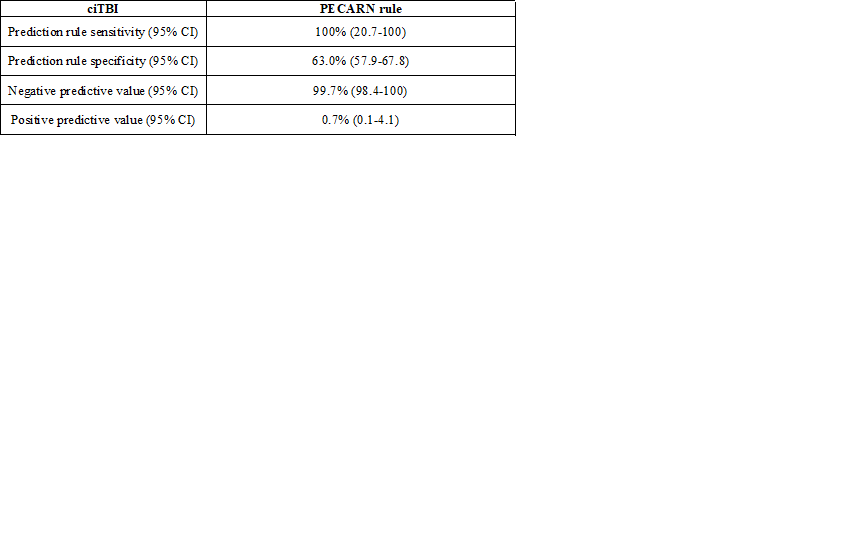Emergency Medicine: All Areas
Category: Abstract Submission
Emergency Medicine II
55 - Does the PECARN rule for Traumatic Brain Injury in children under 2 years old work in Infants Younger than 3 Months?
Friday, April 22, 2022
6:15 PM - 8:45 PM US MT
Poster Number: 55
Publication Number: 55.104
Publication Number: 55.104
José Antonio Alonso Cadenas, Pediatric Emergency Department, Niño Jesús Children University Hospital, Madrid, Madrid, Spain; Rosa María Calderón Checa, University hospital 12 Octubre Madrid, Madrid, Madrid, Spain; Aristides Rivas García, Gregorio Marañón Hospital, Alcobendas, Madrid, Spain; Isabel Duran Hidalgo, Hospital Universitario Málaga, Málaga, Andalucia, Spain; Sara Ruiz González, Hospital Universitario Severo Ochoa, Madrid, Madrid, Spain; María de Ceano-Vivas la Calle, La Paz University Hospital, Madrid, Madrid, Spain; Raquel Jiménez García, NIÑO JESUS CHILDREN´S HOSPITAL, MADRID, Madrid, Spain
.jpg)
José Antonio Alonso Cadenas (he/him/his)
Pediatric Emergency Physician
Pediatric Emergency Department. Niño Jesús University Hospital
Madrid, Madrid, Spain
Presenting Author(s)
Background: Prediction rules for traumatic brain injury (TBI) try to identify low-risk infants in order to minimize the radiation exposure from computed tomography (CT) or X-ray. Previous studies of minor head trauma include infants younger than 3 months within children under 2 years without having analyzed its characteristics in detail.
Objective: To evaluate Pediatric Emergency Care Applied Research Network (PECARN) rule for ciTBI in infants younger than 3 months and determine the risk of clinically important TBI (ciTBI) and TBI on CT and skull fractures prevalence in infants younger than 3 months of age who did and did not meet PECARN low-risk criteria for children < 2 years old with minor blunt head trauma.
Design/Methods: A prospective study conducted on infants < 3 months who presented within 24 hours of head trauma with Glasgow Coma Scale (GCS) scores of 14 to 15 in 13 Spanish Pediatric Emergency Departments between May 2017 and November 2020.
Children were divided in two main groups based on PECARN rule for ciTBI: those who met the PECARN low-risk criteria for children < 2 years and those who did not meet. All infants were followed up in the next four weeks by a telephone call.
Sensitivity, specificity, the negative predictive value and the positive predictive value of the PECARN prediction rule for ciTBI were evaluated. We calculated the frequencies and proportions of ciTBI, TBI on CT and skull fractures in each group and exact binomial confidence intervals (CIs) for the proportions.
Results: Of 21,981 children with minor head trauma, 366 (1.7%) with complete data were < 3 months old; 195 (53.3%) underwent neuroimaging: 37 (10.1%) CT scan, 162 (44.3%) skull radiograph and 22 (6.0%) cranial ultrasound. Characteristics of PECARN prediction rule are shown in table 1. Of the 230 infants (62.8%) who met the PECARN low-risk criteria, none had ciTBI, 1 (0.4% overall, 95% CI 0-2.4) had TBI on CT and 2 (0.9% overall, 95% CI 0.1-3.1) had an isolated skull fracture. Among the 136 infants (37.2%) who did not meet the PECARN low-risk criteria, 1 (0.3% overall, 95% CI 0-1.5) had ciTBI, 11 (8.1% overall, 95% CI 4.1-14.0) had TBI on CT and 18 (13.2% overall, 95% CI 8-20.1) had an isolated skull fracture. None infants on the registry presented any complication during follow-up.Conclusion(s): In our population, the PECARN prediction rule is capable to identify adequately infants < 3 months old at low risk of clinically important traumatic brain injuries, and therefore, reducing useless CT scans.
Table 1. Prediction rule for ciTBI in children younger than 3 months. ciTBI: clinically important traumatic brain injury; CI: confidence interval.
ciTBI: clinically important traumatic brain injury; CI: confidence interval.
Objective: To evaluate Pediatric Emergency Care Applied Research Network (PECARN) rule for ciTBI in infants younger than 3 months and determine the risk of clinically important TBI (ciTBI) and TBI on CT and skull fractures prevalence in infants younger than 3 months of age who did and did not meet PECARN low-risk criteria for children < 2 years old with minor blunt head trauma.
Design/Methods: A prospective study conducted on infants < 3 months who presented within 24 hours of head trauma with Glasgow Coma Scale (GCS) scores of 14 to 15 in 13 Spanish Pediatric Emergency Departments between May 2017 and November 2020.
Children were divided in two main groups based on PECARN rule for ciTBI: those who met the PECARN low-risk criteria for children < 2 years and those who did not meet. All infants were followed up in the next four weeks by a telephone call.
Sensitivity, specificity, the negative predictive value and the positive predictive value of the PECARN prediction rule for ciTBI were evaluated. We calculated the frequencies and proportions of ciTBI, TBI on CT and skull fractures in each group and exact binomial confidence intervals (CIs) for the proportions.
Results: Of 21,981 children with minor head trauma, 366 (1.7%) with complete data were < 3 months old; 195 (53.3%) underwent neuroimaging: 37 (10.1%) CT scan, 162 (44.3%) skull radiograph and 22 (6.0%) cranial ultrasound. Characteristics of PECARN prediction rule are shown in table 1. Of the 230 infants (62.8%) who met the PECARN low-risk criteria, none had ciTBI, 1 (0.4% overall, 95% CI 0-2.4) had TBI on CT and 2 (0.9% overall, 95% CI 0.1-3.1) had an isolated skull fracture. Among the 136 infants (37.2%) who did not meet the PECARN low-risk criteria, 1 (0.3% overall, 95% CI 0-1.5) had ciTBI, 11 (8.1% overall, 95% CI 4.1-14.0) had TBI on CT and 18 (13.2% overall, 95% CI 8-20.1) had an isolated skull fracture. None infants on the registry presented any complication during follow-up.Conclusion(s): In our population, the PECARN prediction rule is capable to identify adequately infants < 3 months old at low risk of clinically important traumatic brain injuries, and therefore, reducing useless CT scans.
Table 1. Prediction rule for ciTBI in children younger than 3 months.
 ciTBI: clinically important traumatic brain injury; CI: confidence interval.
ciTBI: clinically important traumatic brain injury; CI: confidence interval.